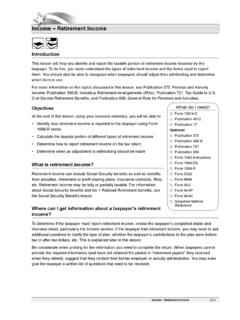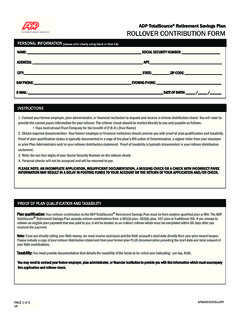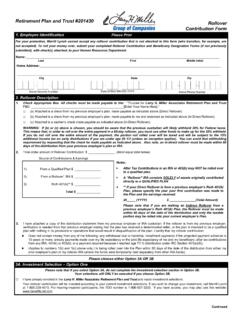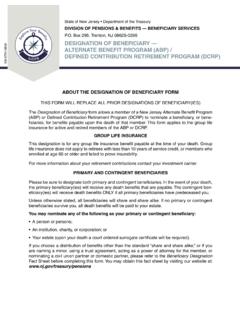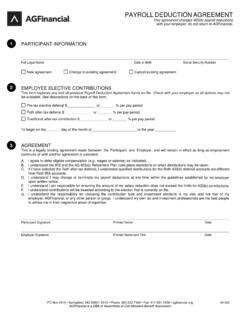Transcription of Business for Small Plans Retirement
1 ContentsWhat's 1. Definitions You Need To 2. Simplified Employee Pensions (SEPs)..5 Setting Up a Much Can I Contribute?..6 Deducting Reduction Simplified Employee Pensions (SARSEPs)..7 Distributions (Withdrawals)..8 Additional and Disclosure 3. SIMPLE IRA 401(k) 4. Qualified of Up a Qualified Funding Deferrals (401(k) Plans )..16 Qualified Roth Contribution 5. Table and Worksheets for the 6. How To Get Tax DevelopmentsFor the latest information about developments related to Pub. 560, such as legislation enacted after we release it, go to 's NewCompensation limits for 2017 and 2018.
2 For 2017, the maximum compensation used for fig-uring contributions and benefits is $270,000. This limit increases to $275,000 for deferral limits for 2017 and 2018. The limit on elective deferrals, other than catch-up contributions , is $18,000 for 2017 and increases to $18,500 for 2018. These limits ap-ply for participants in SARSEPs, 401(k) Plans (excluding SIMPLE Plans ), section 403(b) Plans , and section 457(b) of the TreasuryInternal Revenue ServicePublication 560 Cat. No. 46574 NRetirement Plansfor Small Business (SEP, SIMPLE, andQualified Plans )For use in preparing2017 ReturnsGet forms and other information faster and easier at: (English) (Espa ol) ( ) ( ) (Pусский) (Ti ngVi t) Userid: CPMS chema: tipxLeadpct: 100%Pt.
3 Size: 8 Draft Ok to PrintAH XSL/XMLF ileid: .. tions/P560/2017/A/XML/Cycle04/source(Ini t. & Date) _____Page 1 of 28 16:58 - 12-Mar-2018 The type and rule above prints on all proofs including departmental reproduction proofs. MUST be removed before 12, 2018 Defined contribution limits for 2017 and 2018. The limit on contributions , other than catch-up contributions , for a participant in a de-fined contribution plan is $54,000 for 2017 and increases to $55,000 for benefit limits for 2017 and 2018. The limit on annual benefits for a participant in a defined benefit plan is $215,000 for 2017 and increases to $220,000 for plan salary reduction contribution limit for 2017 and 2018.
4 The limit on salary reduction contributions , other than catch-up contributions , is $12,500 for 2017 and contribution limits for 2017 and 2018. A plan can permit participants who are age 50 or over at the end of the calendar year to make catch-up contributions in addition to elec-tive deferrals and SIMPLE plan salary reduction contributions . The catch-up contribution limita-tion for defined contribution Plans other than SIMPLE Plans is $6,000 for 2017 and 2018. The catch-up contribution limitation for SIMPLE Plans is $3,000 for 2017 and participant's catch-up contributions for a year can't exceed the lesser of the following catch-up contribution excess of the participant's compensa-tion over the elective deferrals that are not catch-up Catch-up contribution under Contribution Limits and Limit on Elective Deferrals in chap-ters 3 and 4, respectively, for more relief for victims of 2016 and 2017 dis-asters.
5 New rules provide for tax-favored with-drawals and repayments from certain Retirement Plans for taxpayers who suffered economic los-ses as a result of disasters declared by the President under section 401 of the Robert T. Stafford Disaster Relief and Emergency Assis-tance Act during calendar year 2016. New rules also provide for tax-favored withdrawals, repay-ments, and loans from certain Retirement Plans for taxpayers who suffered economic losses as a result of Hurricane Harvey and Tropical Storm Harvey, Hurricane Irma, Hurricane Maria, or the California Wildfires in 2017. For more informa-tion, see Pub.
6 976, Disaster pre-approved plan program. Guidance has been issued modifying the IRS pre-ap-proved plan opinion letter program by combin-ing the master and prototype program and the volume submitter program into a single pre-ap-proved plan program. For more information, see Revenue Procedure 2017 41, 2017-29 changes to safe harbor Plans and notices. Guidance has been issued regarding permissible mid-year changes to safe harbor 401(k) and 401(m) Plans and notices. For more information, see Notice 2016-16, 2016-7 for startup costs. You may be able to claim a tax credit for part of the ordinary and necessary costs of starting a SEP, SIMPLE, or qualified plan .
7 The credit equals 50% of the cost to set up and administer the plan and edu-cate employees about the plan , up to a maxi-mum of $500 per year for each of the first 3 years of the plan . You can choose to start claiming the credit in the tax year before the tax year in which the plan becomes must have had 100 or fewer employees who received at least $5,000 in compensation from you for the preceding year. At least one participant must be a non-highly compensated employee. The employees generally can't be substantially the same employees for whom contributions were made or benefits accrued under a plan of any of the following employers in the 3-tax-year period immediately before the first year to which the credit member of a controlled group that in-cludes predecessor of (1) or (2).
8 The credit is part of the general Business credit, which can be carried back or forward to other tax years if it can't be used in the current year. However, the part of the general Business credit attributable to the Small employer pension plan startup cost credit can't be carried back to a tax year beginning before January 1, 2002. You can't deduct the part of the startup costs equal to the credit claimed for a tax year, but you can choose not to claim the allowable credit for a tax take the credit, use form 8881, Credit for Small Employer Pension plan Startup savings contributions credit.
9 Retirement plan participants (including self-em-ployed individuals) who make contributions to their plan may qualify for the Retirement savings contribution credit. The maximum contribution eligible for the credit is $2,000. To take the credit, use form 8880, Credit for Qualified Re-tirement Savings contributions . For more infor-mation on who is eligible for the credit, retire-ment plan contributions eligible for the credit, and how to figure the credit, see form 8880 and its instructions or go to of missing children. The IRS is a proud partner with the National Center for Missing & Exploited Children (NCMEC).
10 Pho-tographs of missing children selected by the Center may appear in this publication on pages that would otherwise be blank. You can help bring these children home by looking at the photographs and calling 1-800-THE-LOST (1-800-843-5678) if you recognize a references are to the Internal Revenue Code unless otherwise publication discusses Retirement Plans you can set up and maintain for yourself and your employees. In this publication, you refers to the employer. See chapter 1 for the definition of the term employer and the definitions of other terms used in this publication.












